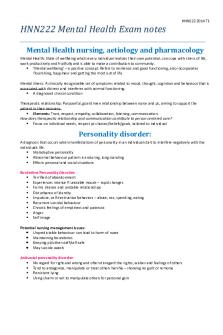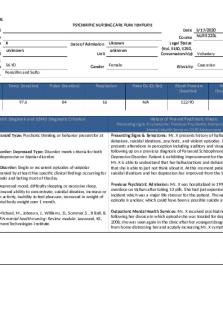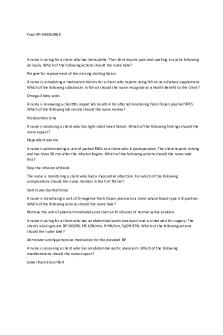Nursing and Mental Health 1 Notes PDF

| Title | Nursing and Mental Health 1 Notes |
|---|---|
| Author | Bethany Sargent |
| Course | Nursing and Mental Health 1 |
| Institution | Victoria University |
| Pages | 62 |
| File Size | 1.3 MB |
| File Type | |
| Total Downloads | 15 |
| Total Views | 165 |
Summary
Comprehensive study notes from all lectures of Nursing and Mental health 1. ...
Description
Week 1: Workshop 1 What causes mental illness? - Severe trauma (emotional, physical or sexual abuse). - Loss (death of a parent). - Social isolation or loneliness. - Severe or long term stress. - Long term physical health conditions. Mental illness is a general term that refers to a group of illnesses that affect the mind. There are many different mental illnesses. • Many mental illnesses may cause you to THINK,FEEL, and ACT differently from what you do now. • Mental ill-health is the single largest cause of disability in Australia • One in five will experience symptoms of mental illness at some stage • There is strong evidence to support that those with a mental illness are also at increased risk of physical illnesses The term ‘Mental Health’ focuses upon the psychological, emotional and behavioural wellbeing of a person or population Department of Health define it as: “…the capacity of individuals and groups to interact with one another and their environment in ways that promote subjective wellbeing, optimal development and use of mental abilities (cognitive, affective and relational); and achievement of individual and collective goals consistent with justice.” (2010) Pysch-iatric versus Psych-ological: • Mental versus behavioural or emotional • ‘neurosis’ versus ‘psychosis’ • Psychological/emotional – person maintains contact with reality, major form of treatment is psychological therapy (but may be combined with medication) • Psychiatric – loss of contact with reality, mostly always requires some form of medication therapy Mental illness doesn’t discriminate. Contributing Factors: • Chemical imbalance in the brain • Drug and alcohol abuse • Hormonal changes • Physical and social stress
• Family history Similarities with the nursing process Assessment: - Data collection & analysis - May not be a felt need Nursing diagnoses & planning: - Mutually set goals Implementation: - Plans initiated Evaluation: - May lead to new plans - Leads to termination Orientation: - felt need - define needs Identification: - interdependent goal setting Exploitation: - Consumer actively seeking help, initiating Resolution: - Leads to termination once other phases completed Todays mental health services: Recovery model • Holistic view of mental illness that focuses on the whole person – not just their symptoms • Full recovery is possible even when symptoms remain • Factors important in recovery include good relationships, financial security, satisfying work, personal growth, right living environment, cultural & spiritual beliefs, resilience to future adversity or stress • Recovery focused nursing believes in the consumer, listens and understands the consumer, provides explanations and enables consumers to temporarily resign responsibility during periods of crisis • Strong links between recovery process, social inclusion, reduced rates of hospitalization/relapse & improved consumer service satisfaction
Todays mental health services: Fourth National Mental Plan, 2014 Five priority areas: • Social inclusion and recovery • Prevention and early intervention • Service access, coordination and continuity of care • Quality improvement and innovation • Accountability – measuring and reporting progress Phases of the Nurse-client relationship: • Pre-Orientation- Self assessment examine own feelings, fears, anxieties. • Orientation – Introductory Phase establish trust, share information with client; discrete self-disclosure. convey support, facilitate healing educate Phases of Therapeutic Nurse: Client Relationship: The Working Phase – Problems identified Exploration- guide client to examine feelings/responses, develop new coping skills Termination Phase – Resolution phase Examine goals achieved; Explore feelings regarding termination Establish plan for continuing assistance Qualities of the effective Nurse: Respect for consumer Availability Spontaneity Hope Acceptance Sensitivity Vision Accountability Advocacy Spirituality Empathy Critical Thinking Unconditional positive regard
Non-judgemental attitude The Psychiatric Interview and Mental health Assessment: Interviewing and assessment: • Establish and maintain rapport • Chief complaint • Use chief complaint to develop differential diagnosis • Use more focused questioning to narrow diff. dx • Follow up vague replies to determine accurate responses to questions • Let patient talk freely to evaluate thought process (3-4 minutes) Rapport • “A good understanding of someone and an ability to communicate well with them” Therapeutic relationship • “An interpersonal process of therapeutic interactions between an individual … and nurse” (Peplau, 1988) Communication skills • Empathising • Active listening • Using silence • Reflecting • Clarifying • Paraphrasing • Summarising • Questioning • Structuring • Pinpointing • Linking • Giving feedback • Confronting • Processing Therapeutic communication • Genuineness • Empathy • Clarity • Assertiveness • Positive regard • Trustworthiness • Responsibility
Active listening • SOLER • S – sit facing the client • O – open posture • L – lean forward towards client • E – establish eye contact • R - relax Interviewing and assessment • Use open and closed questions • Don’t be reluctant to ask about topics YOU or the patient find embarrassing/difficult • Ask about SUICIDE! • Give patient chance to ask questions at the end • Conclude with sense of confidence and hope Interviewing and assessment • Sit at same level as client • If client is dangerous • leave door open • have another person present with you • let client know what you are doing • Do not have stethoscope around neck • Take notes, but maintain eye-contact • Important to obtain outside information • If client signs release (consent) • E.g. from family, friends or outside records Main components of psychiatric interview • Identifying data Age • Race • Relationship-single, married, partner, significant other • Occupational status • Patient sole informant/additional history obtained • Referral source • Chief complaint Identify chief complaint • Describe chief complaint in client’s own words • History of present illness • Describe onset of symptoms
• When began, nature of onset • precipitating event? • Association with alcohol/drugs/medical condition • Use DSM-listing of symptoms which should reflect DSM criteria • First episode?/prior episodes?/ • How does present episode compare with the previous one? • Describe consequence of illness (e.g., family, work, study) • Treatment for current illness • Past psychiatric history • Describe in chronological order • Age of first onset • Describe each episode • Symptoms, severity, treatment received and response to treatment • Number of previous hospitalisations • Number of suicide attempts • Describe in detail • History of self harm/violence towards others • Substance use history • Past medical history Obtain medical history • Head injuries • Seizures • Loss of consciousness • Headaches • Sexually transmitted diseases • Risk factors for HIV • Medications • Helpful to note when medication began, when dose changed • E.g. Zoloft 100mg (started 08/16, increased 11/16) • Allergies
• Allergies Reaction • Family history Age of parent(s), siblings, education, occupation • Relevant information about family’s social, cultural, religious
background • Family history of mental illness, medical illness • Important to ask specific questions • Social history Chronological order of life • What childhood was like • History of abuse: sexual, physical, verbal • Sexual history • Education history • Occupational history • Relationship history • Social supports • Substance use history (or in past psychiatric history) Personal history: • Prenatal and perinatal • Infancy and early childhood • Middle childhood • Adolescence • Young adulthood • Middle adulthood and old age • Medical ROS • Mental status exam MSE refers to current state of client: • Behaviour • Emotions • Thoughts • Perceptions • Sensorium and cognition • Assessment (Axis I-IV) • Treatment plan
Psychiatric Interview continued: OPENING PHASE • Allow client time, space and opportunity to tell her/his Story EXPLORATORY PHASE • Define disturbances and abnormal experiences: • Naturally weave mental state examination into flow of interview • Take note of key points and return to clarify later • Ask about specific items at end of interview • E.g. “At this point, I’d like to ask you some questions that are separate to what we’ve been discussing so far, but will give some important information about you.” CONCLUDING PHASE • Feedback to client and state management plan Organisation of Mental state exam: ‘PAMS GOT JIMI B’ • P – perception • A – affect (objective expression of emotion) • M – mood (subjective experience of emotion) • S – speech (rate, tone, volume) • G – general appearance and behaviour • O – orientation (time, place, person) • T – thought (content, stream) • J – Judgement • I – Insight • M – Memory • I – Intelligence (covers cognitive related aspects) • B – Biological (e.g., medical conditions, drug & alcohol use) Perception • Distortions • Illusions • Depersonalisation (feel detached from themselves), derealisation (person’s sense of world is altered. E.g., things may appear bigger/smaller/strange) Hallucinations: • auditory • visual • tactile and somatic • olfactory • gustatory
Perception What do I ask about auditory hallucinations? • Where are they heard? • Inside/outside the head • Number of voices • Are the voices known to the person? • Do they command the person to do something? • Do they comment on what the person is thinking or doing? • Do they argue with each other? Perception: Eliciting psychotic symptoms • Do you ever experience any interference with your thinking? • Is there any force or power trying to take control of you? • Did you at any time suddenly realise that things had special meaning for you? • Do you hear voices when there is nobody there? • Does the world around you seem to have changed in some way you can’t explain? Affect and mood Based on report, observation and communicated feeling AFFECT • Pattern of observable behaviours that is the expression of subjectively experienced emotional state (weather) MOOD • Pervasive and enduring emotional tone (climate) Affect • Quality (e.g. depressed, elevated, anxious) • Range and reactivity (e.g. diminished, blunted, shallow) • Appropriateness (keeping with what is being said or what is happening) Quality of affect • Euthymic (neutral) • Depressed or dysphoric (state of unease, dissatisfaction or restlessness) • Elevated • Anxious • Irritable • Perplexed (anxious bewilderment Range of affect CONSTRICTED • Reduction in the intensity of emotional tone
BLUNTED • Severe reduction in intensity of emotional tone • Implies a lack of emotional sensitivity to others FLATTENED • Absence of any emotional expression • Limitation of the usual range of emotion Reactivity of affect • Degree to which external factors influence emotional expression • Labile affect • Abnormal variability in and control of affect with repeated, rapid and abrupt shifts Appropriateness of affect The degree to which visible emotions match thought content • Appropriate • Inappropriate • Fatuous or silly Mood • Euthymic • Depressed • Elated / euphoric • Expansive • Angry / irritable Speech Verbal expression: utterances, words, phrases and sentences • Rate and spontaneity • Quantity • Volume • Tone • Melody • Coherence • Perseveration (repetition of word, phrase, gesture) Pressure of speech • Different to rapid speech (e.g. anxious person) • Slow (e.g. depressed) • Uninterruptible, intrusive quality, as if compelled to speak • Accompanied by sensation of racing thoughts
General appearance and behaviour Describe what you see: • Appearance - age / weight / make up • Grooming and hygiene - e.g. dishevelled, unkempt • Dress - type / appropriateness / care • Jewellery, tattoos • Gait • Demeanour – comfortable, rigid, anxious, suspicious, guarded • Social manner • Cooperation, eye contact • Verbal and non-verbal • Movements • Agitation / retardation • Stereotypes, mannerisms, tics • Disorders of posture • Medication side effects • Responses to internal stimuli
General appearance and behaviour : Examiner’s subjective reaction to client • Optional, difficult to define, but vital for assessment of rapport, affect, presence of psychosis and quality of therapeutic relationship • Assess: • Veracity (accuracy, conformity to facts, truthfulness) • depth of disclosure • “warmth” • feelings generated in you by client Orientation • Level of consciousness • alert clouding drowsy stupor coma • Orientation • time, person, place, day, date, month, year • Attention and concentration • e.g. serial 7s or 3s • Memory • immediate recall, short-term, long-term • Abstraction ability • General knowledge Thought Inferred from client’s speech and language
• Stream • Form • Content Thought Normal Thinking: • Logical - Sequential - Coherent • An uninterrupted sequence of thoughts that are associated with each other and goal-directed Thought: Retardation: e.g. “I … thought … I … might … throw … myself … off … a … bridge” Thought: Flight of Ideas: Nearly continuous flow of accelerated speech • Words and sentences maintained • Connection between ideas apparent • Rapid and frequent shifts in topic • e.g. “Small things come in good packages. I cut myself opening mail yesterday, it still stings. I got stung by a bee last summer, but it’s only fair as I eat honey. I have breakfast every morning … Thought: Circumstantiality: Understandable words, proper grammatical sequence, but with unnecessary detail • Take account of cultural considerations here Thought: loosening of associations: Connection between ideas not obvious, unclear or nonsensical • e.g. “I don’t think on such a small level. I cut myself opening my mail yesterday. I have breakfast every morning Thought: Thought blocking: • Sudden, involuntary interruption of thought (and speech) • Experienced as losing train of thought or having an idea removed from consciousness • e.g. “They have good team this year. They made some changes … I’ve got to catch a midnight train.” Thought: Neologisms • The invention of new words of phrases or the use of conventional words in idiosyncratic ways • Derailment • Similar to looseness of association. A breakdown in the logical connection between ideas and the overall sense of goal-directedness. The words make sentences, but the sentences do not make sense.
• Perseveration • Repetition of out of context words, phrases, ideas, gestures Thought: Thought content: Refers to what client says or thinks • Start an interview in an unstructured way in order to what person talks about spontaneously • Explore along lines of who, what, where, when, why and how Thought: Delusions • Fixed, false belief based on incorrect inference of reality • Not altered with proof to the contrary • Preoccupies patient to great extent • Places patient at centre of events • Not ordinarily accepted by other members of person’s culture Thought: Overvalued ideas • Less firmly held beliefs and usually less bizarre or absurd • e.g. superstitions or magical thinking Thought: Delusions according to content • Bizarre (impossible) and non-bizarre (possible) • Persecutory (paranoid) • Grandiose • Infidelity and jealousy • Somatic - odour, infestation, appearance • Erotomania (believes another person is in love with her/him) • Passivity or control • etc Thought: How do I ask about delusions? • Listen for themes during interview • What things are important to you? • Do you ever feel thoughts are being put into you mind? (insertion) • Do you ever feel your thoughts are leaving your mind and being transmitted to others? (broadcasting) • Do you ever find that you thoughts stop and leave your mind a complete blank? (block) Thought: Other abnormalities of thought content • Obsession • thought, impulse or image • recurrent, persistent, unwanted (ego-dystonic: thoughts & behaviours that conflict with or are inconsistent with person’s beliefs and personality ) • recognised as own, irrational, uncontrollable
• resisted, but causes dread or anxiety • Compulsion • urge to act in some way to relieve anxiety • Phobia • marked and persistent fear about certain object or situation • associated desire and attempts to avoid stimulus Thought (content): Suicidality • Must always assess • Ideation, intent, plans • Central feature in thought processes shown to be hopelessness as long-term risk factor • Also: guilt, shame, humiliation, desperation • Asking about suicidality does not cause patients to become suicidal or take suicide as suggestion Judgement • Capacity for rational problem-solving during interview • E.g. What would you do if you found a sealed, addressed and stamped envelope on the street? Insight (or awareness) • To what extent does the client understand he/she is ill? • Awareness of the causes of the illness and problems? • Understand his/her environment and reality? • Attitude to need for treatment?
Summary • Appearance and behaviour
• Affect and mood • Speech • Thought • Perception • Cognition • Insight and judgement • Subjective experience Theories of Mental Health examination: Key mental health nursing theories • Hildegard Peplau’s ‘Theory of Interpersonal Relations’ • Phil Barker’s ‘Tidal Model’ Others theorists (for example): • Orem • Rogers • Henderson Hildegard Peplau’s (1909-1999) Theory of Interpersonal Relations According to Peplau, there are six key ‘roles’ of the nurse in a mental health setting: 1. Stranger role 2. Resource role 3. Teaching role 4. Counselling role 5. Surrogate role 6. Leadership role Stranger role • Peplau felt that at the initial meeting between the nurse and consumer, the nurse and the consumer are strangers. • Therefore, as always, the consumer is then afforded respect, as much as anyone (i.e. the nurse should not prejudge based on the ‘condition’). – The consumer is treated as an individual, rather than a diagnosis. – Nurse is non-judgemental towards the consumer Resource role • Consumer looks to the nurse for information • The nurse can provide answers to questions with a focus on health information. • The nurse is a ‘conduit of information’ for the consumer. • Consumer looks to the nurse as a role model
Teaching role • Peplau felt that there are two categories of ‘teaching roles’ for the nurse: – Instructional: Providing a wide range of information to the consumer – Experimental: Using the experience of the consumer as a basis for building further learning by the consumer Counselling role • Peplau believes that counselling is a priority role for the nurse in mental health nursing. • Here the nurse facilitates the consumer's understanding of the current problem, what is going on, and to develop an awareness of how the current problem impacts other aspects of their lives. • Peplau sees nurses as having a significant role in building motivation via encouragement to change. Surrogate role • The consumer is responsible for putting the nurse in the surrogate role. • Nurses are able to act as an ‘advocate’ for the consumer. Leadership role • Fosters a belief that the consumer has significant (maximum) responsibility for meeting treatment goals. • The consumer should be an active participant in the work toward meeting goals. Peplau's Four Phases of the Nurse-Client Relationship • Orientation Phase • Identification Phase • Exploitation Phase (Working Phase) • Resolution Phase (Termination Phase) Orientation Phase • The orientation phase is initiated by the nurse. • The problem is defined. Assessment takes place • This is the phase during which the nurse and the consumer meet, establish therapeutic relationship/ rapport, trust and boundaries, which will ultimately be person-centred. Identification Phase • Consumer accepts that he/she can rely on the nurse for support • The consumer begins to identify problems to be worked on within relationship, care planning occurs in collaboration with the nurse – The nurse’s goal assist the consumer to recognise their own interdependent/participation role and promote responsibility for self
Exploitation/ Working Phase • During the Working Phase, the nurse and ...
Similar Free PDFs
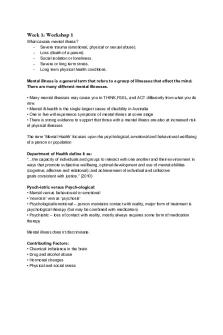
Nursing and Mental Health 1 Notes
- 62 Pages

Uworld Mental Health Nursing
- 168 Pages
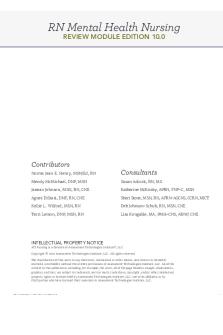
ebook for mental health nursing
- 219 Pages
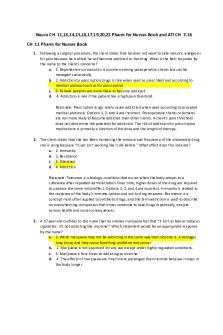
ATI TEST - mental health nursing
- 38 Pages

Mental Health Exam 1 notes
- 51 Pages

Mental health notes
- 57 Pages

Mental health notes
- 45 Pages

COMMUNITY HEALTH NURSING NOTES
- 2 Pages

Mental health quiz 1
- 2 Pages
Popular Institutions
- Tinajero National High School - Annex
- Politeknik Caltex Riau
- Yokohama City University
- SGT University
- University of Al-Qadisiyah
- Divine Word College of Vigan
- Techniek College Rotterdam
- Universidade de Santiago
- Universiti Teknologi MARA Cawangan Johor Kampus Pasir Gudang
- Poltekkes Kemenkes Yogyakarta
- Baguio City National High School
- Colegio san marcos
- preparatoria uno
- Centro de Bachillerato Tecnológico Industrial y de Servicios No. 107
- Dalian Maritime University
- Quang Trung Secondary School
- Colegio Tecnológico en Informática
- Corporación Regional de Educación Superior
- Grupo CEDVA
- Dar Al Uloom University
- Centro de Estudios Preuniversitarios de la Universidad Nacional de Ingeniería
- 上智大学
- Aakash International School, Nuna Majara
- San Felipe Neri Catholic School
- Kang Chiao International School - New Taipei City
- Misamis Occidental National High School
- Institución Educativa Escuela Normal Juan Ladrilleros
- Kolehiyo ng Pantukan
- Batanes State College
- Instituto Continental
- Sekolah Menengah Kejuruan Kesehatan Kaltara (Tarakan)
- Colegio de La Inmaculada Concepcion - Cebu

